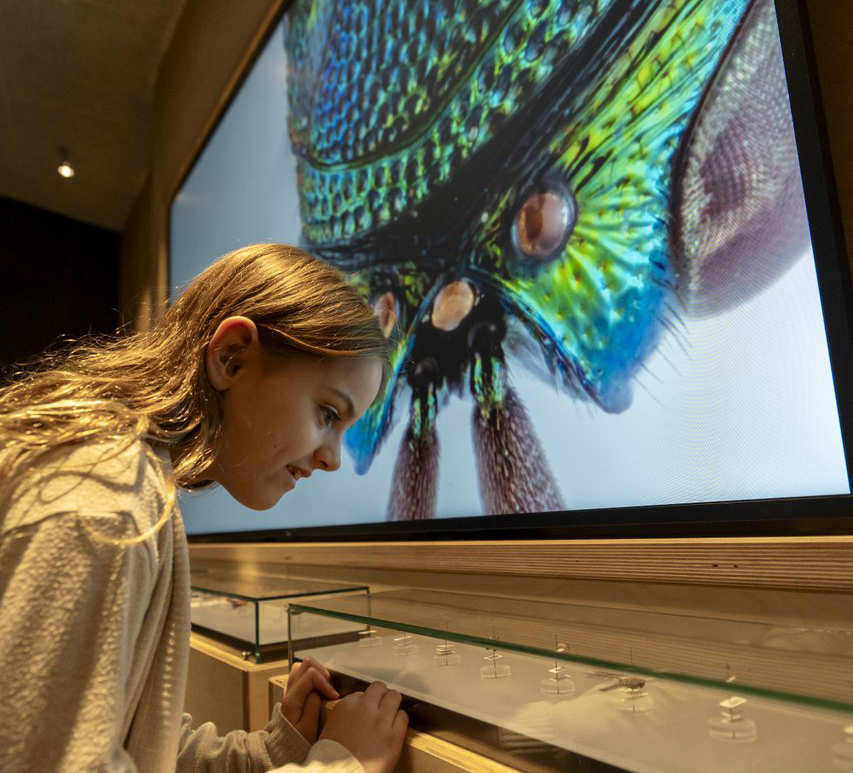It feels like just yesterday I was kicking off my second field season, and writing my last blog entry. Unfortunately, that was FOUR MONTHS AGO and now my second field season is officially in the books. I’m sure I’m not the only one wondering where in the world the summer disappeared to. Now I’m back at the U of R analyzing data, creating maps, and prepping lab samples, and the turtles are prepping for overwintering. Last week I was able to get out on the water and check on their locations (I will be continuing this every other week until the water freezes), and all the turtles I’m tracking appeared to be in their overwintering sites. Judging by the snow that’s outside right now, that’s probably for the best! But enough about the chilly weather, what happened this summer when it was sunny and warm!
Well, my field tech and I were kept on our toes. It was a busy, busy summer. It was off to a fast start with the warm spring, and then it never slowed down. This resulted in my radio silence, but I hope I can make up for it with this blog.
So what are some highlights?
1. The turtles really moved.
It was great, but physically hard, to see the change in space use from the summer of 2015 to the summer of 2016. This summer, the turtles expanded the site by about 10 km (measured by the creek flow not the way the crow flies). This may not seem like a huge number, but when you’re paddling around in a canoe in conditions that aren’t always calm and beautiful, it can be a bit of a struggle. I think the strongest winds we paddled in this summer were about 50 km/h. It was incredibly slow going, but unfortunately the only way to find the turtles is to be on the water, we can’t track them from land. On days when we were graced with calm waters, it took everything in our power to refrain from saying how nice it was to have calm water because the second we uttered that sentence, Mother Nature would send gale force winds in our direction. As a bit of a visual, below is a map of my study site. The area outlined in yellow shows the study site of summer 2015, the area outlined in pink/red is the extension of the study site. The turtles moved to drainage ditches by the airport, up by Dewdney, and over to what felt like us was almost White City (it was not….but boy was it far…).

Study area comparison between 2015 (yellow) and 2016 (yellow and pink) field seasons.
2. My parents were able to come and help out on the project.
This is a totally biased highlight, but honestly they were some of the best highlights this year. Both my mom and my dad came out from Ontario to help on the project at two different times. Having them out in the field seeing what I do, and helping collect turtles was absolutely fantastic. Both of them were able to capture turtles for me, help me track, and help me set up study points. They too braved the sun and wind, and did it with a smile on their face. Being able to share this aspect of my research with my parents was truly rewarding, and I know they both absolutely loved the experience.
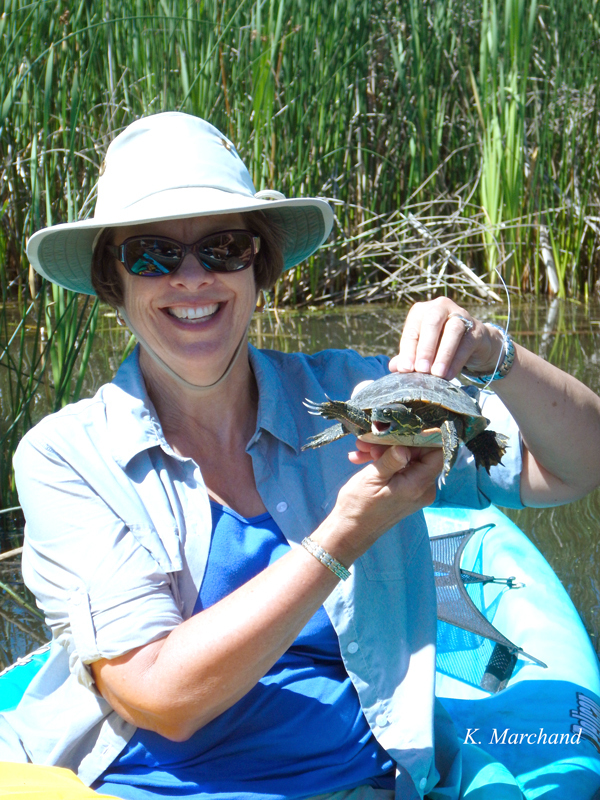
My mom (Janice) holding Carson after we re-epoxied his transmitter to his shell.
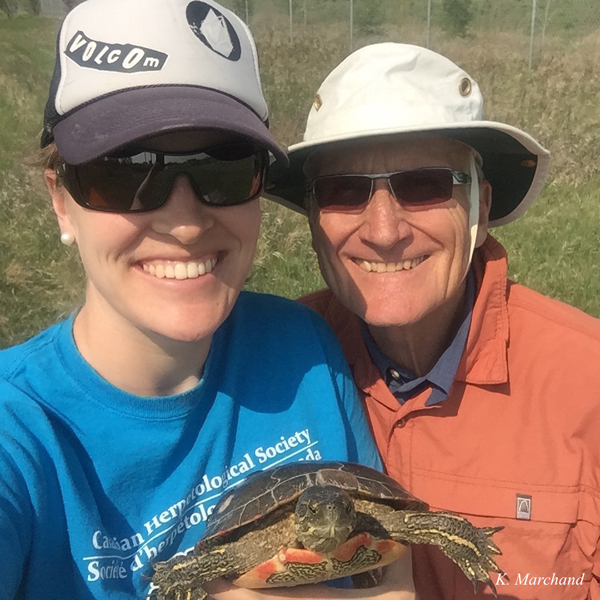
My dad (Jim), Chay, and I. Chay’s transmitter malfunctioned and we spent a whole day trying to figure out where Chay would be, and then once we found him (by accident), try and catch him. About 5 hours later we were successful. Milky Way was in order as a reward!
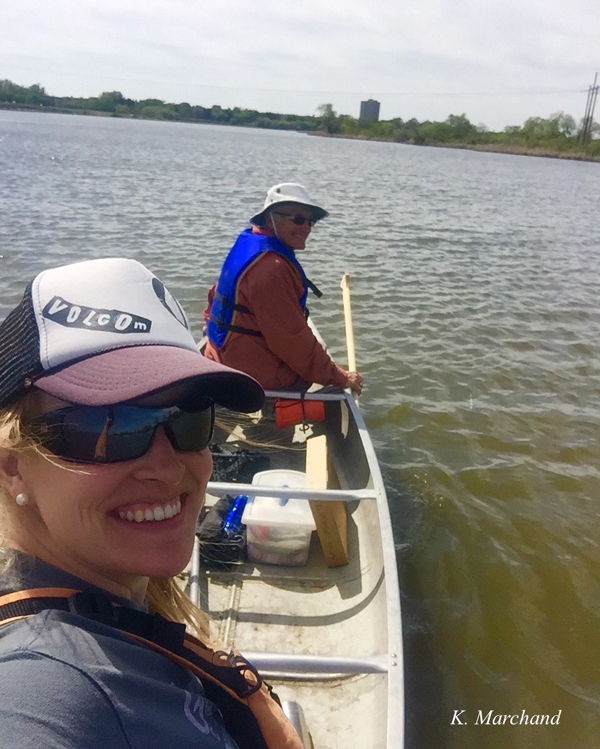
My dad and I out on Wascana after we finished setting up sampling sites for turtle prey!
3. Finding Tonks.
This was definitely a highlight of the summer. As many previous blog readers know, every year painted turtles shed a layer of their scutes. This isn’t very good for me, as the transmitters I use are epoxied to the outside of their shell. Meaning, if I don’t catch them in time, the turtles will loose their transmitters and I will loose them. This happened last year with Tonks. Tonks was the very first turtle that we caught to be part of the project. She held a special place in our hearts and in the project, however in August of last year she dropped her transmitter and escaped from the project. HOWEVER this past June we were able to find her again!!! It was completely by accident, but it made me ever so happy. Luckily I still had a transmitter on hand and so she was able to get a new transmitter (I don’t think she thought she was lucky…) and I was able to track her again this year! Boy did she move. She made us paddle about 15 km roundtrip just for her!!! Her favourite place to be is in the creek east of Ring Road, and this summer she swam up past the Ducks Unlimited property on the east end. I was sure she was headed for White City. As much as I disliked having to paddle so far to get her, I am so happy to have had her back in the project because it helped us to better understand the space use of the turtles in Wascana Marsh.
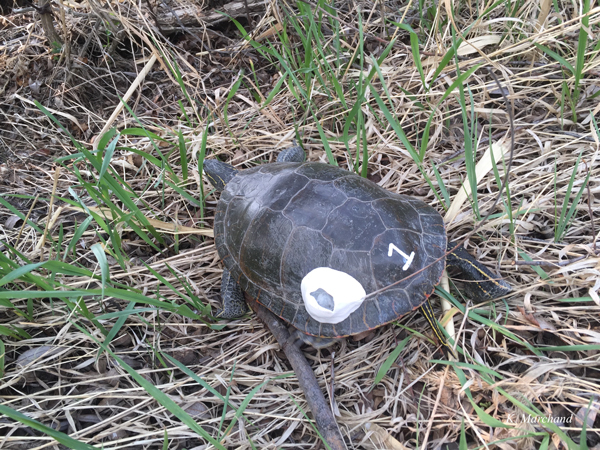
Tonks with her fresh transmitter and number.
4. JUVENILES!
Juveniles are always a highlight simply due to their cuteness, but also because it means recruitment!!! Juveniles are also impeccably hard to find, so when you do find them, you celebrate. This year we were able to find five new juveniles (excluding the hatchlings from the last blog). One of them we were able to find TWICE. Although being able to capture him/her twice may not be such a good thing, it was incredibly interesting because the little gaffer was able to move just under a km within a week. Although this is a distance that the adult turtles could do in a matter of hours, its quite astounding that a turtle that is about half the size of a cookie from Tim Hortons could travel such a distance. It starts to create new questions as to why that little gaffer would feel the need to risk his/her life to travel across the marsh. What could he/she get in that new location that wasn’t available in another spot that was 1 km closer?
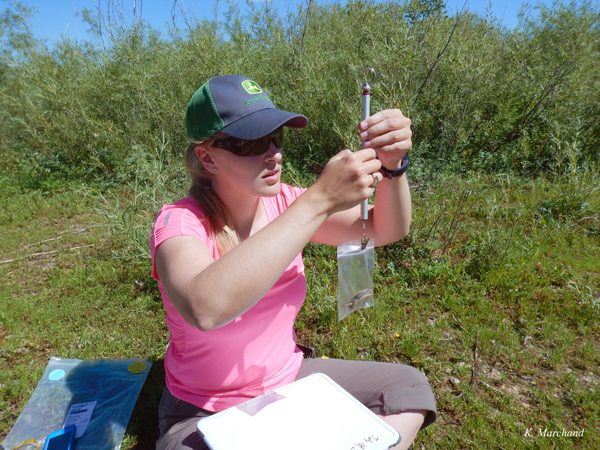
Weighing juveniles is tricky when they weigh less than the reusable shopping bag you typically use to weigh the turtles. It called for some ziplock bag improvisation (note – the bag isn’t zipped and the turtle was in there for maybe 15 seconds).
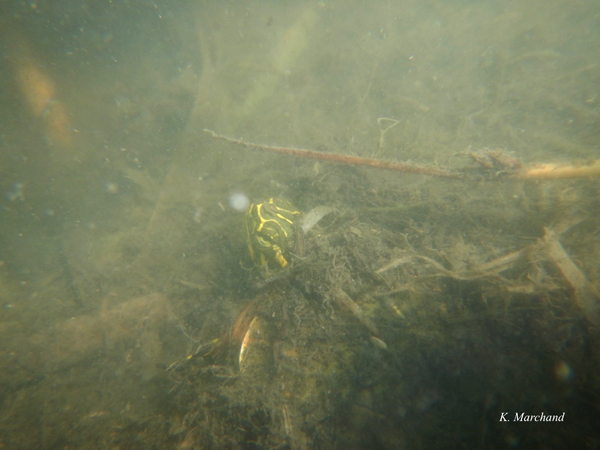
A juvenile we dubbed Pancake (he/she was incredibly flat), displaying why juveniles are so hard to find. If I didn’t watch Pancake burrow into the muck, I never would have known he/she was there.
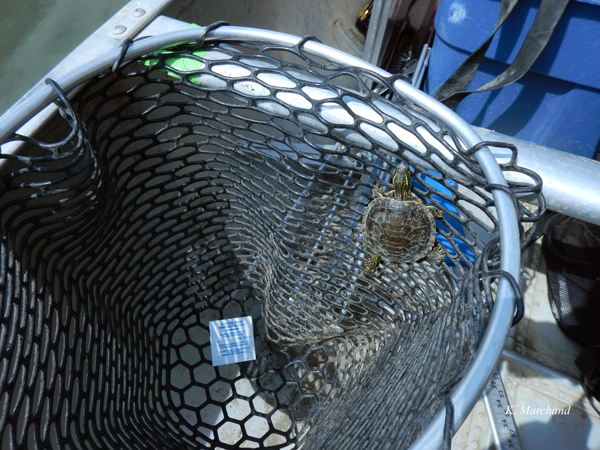
A juvenile we named Spiderman due to its impeccable climbing skills. He/she never made it out, but boy it got close a couple times.
5. Turtles and cars.
This definitely wasn’t a highlight, this was an incredible low, however, there are some amazing groups here in Regina that made this low into a great high. You may have heard through media that this summer we had a couple car/turtle encounters. This is incredibly common in areas where there are a lot of road networks intersecting habitat (ex. Ontario). In these areas, road mortality is one of the major factors leading to population declines. Here in Regina, this didn’t appear to be much of a problem. My first summer here, I asked around and no one seemed to have heard of turtles being hit on roads and none of the turtles I was tracking ever seemed to use roads. This year, things were different. This year I had a report of someone who watched a driver purposely swerve to drive over a turtle crossing Broad St. Luckily for the turtle, the turtle went between the tires and wasn’t hit. Once it was safe to get on the road, the friendly Samaritan went out and grabbed the turtle from the road and moved it across to the lake (where it was headed). The turtle didn’t appear to be harmed AND it was one of the turtles that had a radio transmitter.
A week or so later, we caught a turtle that had cracks in her plastron. Catching her was a big fluke but I am so happy we did. We brought her to Albert North Vet Clinic and they were able to take some x-rays and diagnose her injuries. Luckily for her, aside from the cracks, everything else seemed to be fine. Also, in the x-rays we were able to see that she was carrying eggs! So presumably, she was out looking for a nesting site when the encounter occurred. This turtle, named Sophia, was then brought to Salthaven West to be rehabilitated while her injuries healed. At the end of August, this lucky girl was able to be released back into Wascana after receiving a clean bill of health.
July 2nd, a week after we found Sophia, we were tracking the study turtles and we came across Abby. She was hanging out in a shallow area and was moving quite slowly so I decided we would pick her up and check her out. Unfortunately I soon discovered that she too had been victim to a car encounter, and she was not as lucky as Sophia. She had road rash on her plastron, and her skin was scraped off her legs exposing bone. Had we not caught her when we did, her wounds would have become more infected than they were and she could have succumbed to those injuries. Dr Fisher at Albert North Vet Clinic was able to clean up, stitch up, and bound up her injuries, and then she too was brought to Salthaven West for some rehabilitation. Unfortunately she hasn’t healed fully yet, so she will be spending the winter at the facility and will hopefully be released in the spring or early summer.
Long story short, please keep an eye out for turtles as you’re driving around Wascana. If you see a turtle, please try and help it across the road in the direction its facing if its safe to do so. Please try not to straddle the turtles with your car. Your car rides lower than you think, and you could end up dragging the turtle beneath your car.
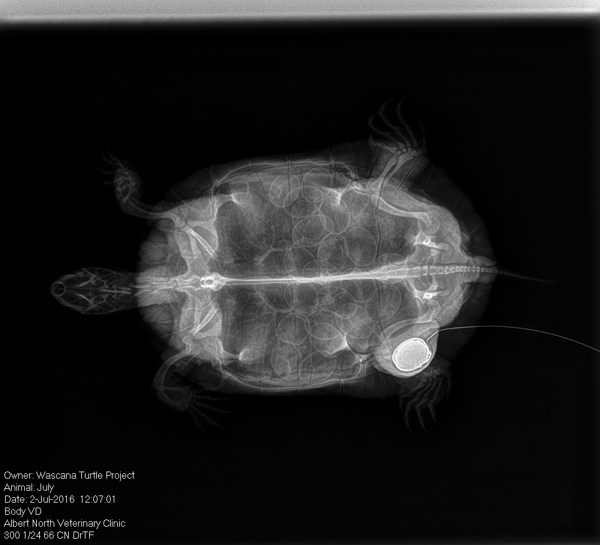
Abby’s super cool x-ray! You can see her transmitter AND HER EGGS!!! She was also carrying a clutch, and this was her SECOND clutch of the summer!
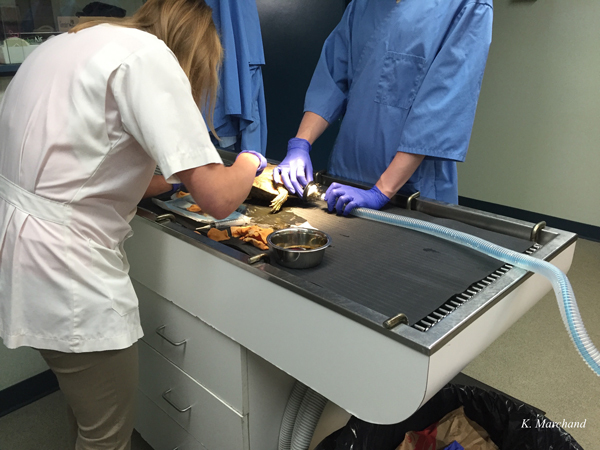
Dr. Fisher and her assistant at the Albert North Vet Clinic cleaning up Abbys wounds.
This whole field season was full of stories, so I think that I’m going to have to make another blog post otherwise people will never make it to the end. I hope that this blog will keep everyone entertained, and will allow you to forgive me for my radio silence. I promise to write another one soon, and to continue to tell you about all the cool things I’ve been up to with the Wascana Turtle Program.

